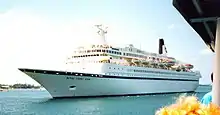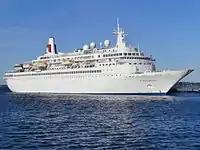Royal Viking Line
The Royal Viking Line was an upmarket cruise line that operated from 1972 until 1998. The company was the brain child of Warren Titus[1] and had its headquarters at One Embarcadero Center in San Francisco.
 | |
| Type | Cruise Line |
|---|---|
| Industry | Travel & Tourism |
| Fate | Merged into Seabourn Cruise Line |
| Successor | Seabourn Cruise Line |
| Founded | 1972 |
| Defunct | 1998 |
| Headquarters | One Embarcadero Center San Francisco, CA, USA |
Key people | Warren Titus |
| Products | Cruises |
| Parent | Kloster (from 1986) |
History
The First Ships
Each of the line's initial three vessels was owned by one of its initial investing partners. The first, the Royal Viking Star, was completed in July, 1972. Its owner was Bergenske Dampskibsselskab (Bergen Line). The second, the Royal Viking Sky, was owned by Nordenfjeldske Dampskibsselskab of Trondheim. She was completed in July 1973. The third ship, the Royal Viking Sea, was ready in December of the same year. Her owner was A. F. Klaveness & Co, Oslo.[2]
Warren S. Titus became the first president of Royal Viking Line, which established its US head office in San Francisco.
The ships were all built by Wärtsilä Helsinki New Shipyard, Finland, and were each approximately 21,500 gross register tons (GRT) and nearly identical in appearance, with a tall superstructure and a single, scooped funnel. However, the Star was two feet shorter (581 feet), and her interior arrangement differed slightly from her two fleet-mates. Each ship featured a double-height theatre occupying an interior space on the two lowest passenger decks; however, on the Star the space just forward of the theatre on the higher of these decks was occupied by a chapel, a feature not found on either of her fleet-mates, nor any of the Scandinavian-built cruise ships of that generation. Other differences included the placement of small lounges and facilities such as the library.
These vessels were intended for longer voyages to exotic destinations, and a significant percentage of the line's passengers were wealthy retirees. As such, they featured numerous single staterooms and suites, and thus their capacity was only about 550 compared to 750-850 on similarly-sized ships of other lines. Royal Viking Line prided itself on single-seating dining, and the restaurant was situated unusually high in the ship, with large windows. Another popular feature was a glass-enclosed lounge high atop the bridge, which afforded excellent views.
On May 1, 1976 the Royal Viking Sky and Royal Viking Star became the first sister ships to have transited the Panama Canal simultaneously in different directions, the Sky sailing westbound and the Star eastbound.
Stretching and Adding to the Fleet
Beginning in 1980, under the leadership of then CEO Torstein Hagen, each of the three ships was stretched to 28,000 GRT by adding a 93-foot prefabricated midships section at the AG Weser shipyard in Bremerhaven. This increased each ship's capacity by 200 passengers and mainly included the addition of cabins. Aft of the observation lounge, a new lounge and nine penthouse suites with balconies — a cruise industry first — were added. The size of the main restaurant was also doubled and now occupied nearly half of one deck in order to maintain single-seating dining. Royal Viking Star was stretched in 1981, followed by Royal Viking Sky in 1982 and Royal Viking Sea in 1983.
The lengthening of the ships improved both their profiles and their economics. In 1984, Torstein Hagen arranged a $240 million management buyout of the company, with the assistance of venture capital firm JH Whitney. After the buyout had been announced, but before it closed, the two companies owning Royal Viking decided to sell the company instead to Norwegian Caribbean Line, then part of the Kloster group. The offices were moved to Coral Gables, Florida, and Warren Titus departed in 1987. While under Kloster ownership, Royal Viking built a fourth ship, the Royal Viking Sun. Constructed by Wärtsilä in Turku, Finland, she was 38,848 GT and carried 850 passengers. The final ship built for Royal Viking was the Royal Viking Queen completed in 1992. She was just 9,961 GT, carrying only 212 passengers and sharing a general arrangement with the Seabourn Pride and Seabourn Spirit of Seabourn Cruise Line; the new home of Warren Titus.
Shrinking the Fleet and End of Royal Viking Line
In 1990 and 1991, Kloster moved the Royal Viking Star and the Royal Viking Sky to its Norwegian Cruise Line brand, where they became the Westward and the Sunward and the Royal Viking Sea to its Royal Cruise Line brand, where she took the name Royal Odyssey.
In 1993, the Westward ex Royal Viking Star became the Star Odyssey for Royal Cruise Line. The passenger capacity on each of the original three ships had been increased to 850, mainly with the addition of staterooms amidships on the Bridge Deck, in what used to be officers' quarters. A buffet was also added in the lounge on the top deck, since the ships did not have the casual indoor/outdoor dining area (often called a Lido) that was becoming de rigueur. That same year, the Sunward ex Royal Viking Sky was leased by Princess Cruises which operated her for one year as the "Golden Princess."
In 1994, when Kloster Cruise was in financial difficulties, the Royal Viking Line was dissolved. Royal Viking Queen was transferred to Royal Cruise Line as Queen Odyssey, while Royal Viking Sun and the Royal Viking brand were sold to Cunard Line Ltd. Cunard continued to operate the ship under the Royal Viking brand as a special segment of the Cunard fleet. Following acquisition by Carnival and a merger with Seabourn Cruise Line, Cunard's Royal Viking and Sea Goddess fleets were consolidated with Seabourn Cruise Line, officially ending the use of the brand.
Former Fleet
| Ship | Built | In service for Royal Viking Line | Tonnage | Image |
|---|---|---|---|---|
| Royal Viking Star | 1971 | 1972-1991 | 21,847 GRT |  |
| Royal Viking Sky | 1973 | 1973-1991 | 21,891 GRT |  |
| Royal Viking Sea | 1973 | 1973-1991 | 20,018 GRT | _(cropped).jpg.webp) |
| Royal Viking Sun | 1988 | 1997-1999 | 38,848 GT | .jpg.webp) |
| Royal Viking Queen | 1992 | 1992-1995 | 9,961 GT | .jpg.webp) |
References
- Maxtone-Graham, John Crossing and Cruising New York: Charles Scribner's Sons, 1992.
- Dawson, Philip Cruise Ships: An Evolution in Design London: Conway Maritime Press, 2000.